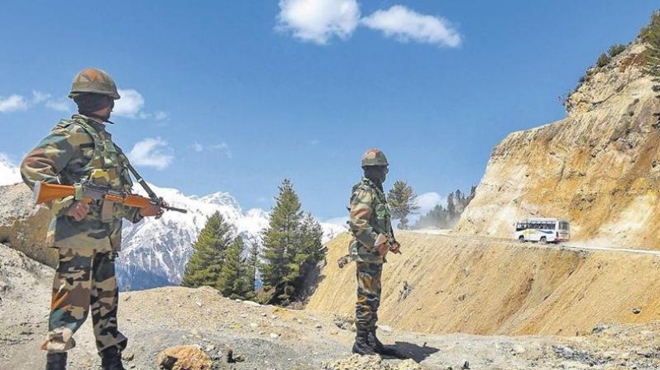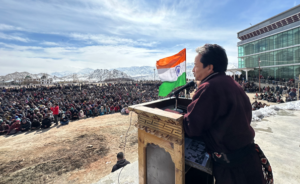M.K. Bhadrakumar
The good thing about the nihilistic Indian media narratives — relentlessly negative — over the military standoff in eastern Ladakh is that the government largely disregarded them. Hopefully, a de-escalation of tensions is on cards.
Nihilists and cynics are best shunned. Especially when they also happen to be Sinophobes with a tunnel vision of the contemporary world situation who blithely overlook that China is a major player in the superpower league.
Some dominant narratives even demanded that Indian Army should give a ‘bloody nose’ to the Chinese PLA. The assumption appears to be that the current US-China tensions catapult India into a position of great strategic advantage at a time when China stands ‘isolated’ and its internal politics is in disarray.
Unsurprisingly, some American analysts, who wielded influence in the Beltway in the bygone pre-Trump era, have also jumped into the fray to hustle India, counselling we shouldn’t waste anymore time to ‘join the rest of Asia in figuring out how to deal with the newest turn in China’s salami-slicing tactics, which now distinctively mark its trajectory as a rising power.’
However, the Indian leadership held a steady line so far to seek a peaceful resolution of the tensions on the northern border. Over a month ago, when the Chinese build-up began, National Security Advisor Ajit Doval spotted it like ‘a cloud, as small as a man’s hand’, as the Bible says, and post-haste engaged with Chinese Politburo member Yang Jiechi, reportedly on May 6.
No doubt an inflection point has been reached — a time of significant change in the direction of the curvature ahead for the Sino-Indian relationship. Significantly, Doval didn’t wait for President Trump’s mediatory offer (which sailed into view only three weeks later) to contact Beijing directly at the highest possible level next only to Xi Jinping.
Trump said Washington had ‘informed both India and China that the United States is ready, willing and able to mediate or arbitrate their now raging border dispute.’
Now, it is a stunning offer. By offering to mediate, Trump displayed his interest in being objective and impartial. He signalled he won’t take sides — stretching further, he doesn’t intend to wade into the India-China tensions as such or get entangled in it.
The Indian analysts who are raring to give a bloody nose to the PLA — many of whom also happen to be cheerleaders of US-Indian ‘partnership’ — fail to understand the meaning of Trump’s mediatory offer. if India takes ‘police action’ (as Nehru once vowed), it will have consequences no less disastrous than what we faced six decades ago. Today, ‘police action’ against China means war with a superpower where India will not be at liberty to prescribe its parameters or timeline.
Don’t our ‘China experts’ read newspapers? The prognosis worldwide is that India is cruising toward the epicentre of the Covid-19 pandemic, while on the other hand, the World Bank says the Indian economy is due to shrink by over 3 percent by the yearend.
Besides, there is another side to all this — the unpredictability and inconstancy of US-China relations, which has profound implications for Indian policymaking.
Prima facie, nothing would suit Trump better than to join his Secretary of State Mike Pompeo’s roadshow on the Chinese Communist Party and make India’s Ladakh tensions a golden opportunity to lock India in as a US ally to confront China. But Trump is disinterested. This can only mean that Trump takes a 360-degree view of the US-China relationship.
Stephen Roach at Yale University, formerly Chairman of Morgan Stanley Asia, and a noted China specialist, wrote a thoughtful essay in Bloomberg yesterday how the tension between saving and the current deficit in the US economy is assuming a new criticality with the pandemic, as the crisis-related expansion of federal deficit is galloping away by far outstripping the fear-driven surge in personal saving.
Roach sees a tipping point ahead and the domestic saving plunging — that is, if the US-China trade tensions effectively tax beleaguered US consumers, which, combined with a weaker dollar would make external funding of saving deficit impossible to sustain, especially if Trump indeed presses ahead with his ‘poorly timed wish for financial decoupling from China.’
Quite obviously, Trump’s statement of May 29 on Actions Against China (which was, interestingly, made after the disclosure of his mediatory offer on Ladakh) was high on rhetoric while he actually followed up with only a few symbolic moves to ‘punish’ China — and he steered clear of any references to trade with China — so much so that the stock market got thrilled, taking it as signalling a potential easing of US-China trade tensions!
Suffice to say, our narratives on China need to be co-related with the international environment. Even senior cabinet ministers began harbouring fanciful notions that US companies are exiting China in droves and heading toward India to set up production centres! Knowledgeable business friends of India in the US have had to step in to disabuse us of such notions.
Sure, China is not having an easy time as it enters the big league in global politics. But that’s how it has been in history, as entrenched powers do their utmost to keep out aspiring powers. China has problems with not only the US but also with Europe. Nonetheless, a point has been reached where big powers realise that a modus vivendi with China has become necessary in a multilateral world order.
When it comes to India’s predicament, the tragic downhill slide toward the 1962 war cannot be forgotten. That conflict also stemmed largely out of fantasies. There is a world of difference between a Line of Control and a Line of Actual Control. An earthy realism and pragmatism is needed to survive and thrive.
Geopolitical circumstances are such today that it is not possible to sequester the tensions in Ladakh and regard them merely as a territorial dispute. Wuhan, Chennai — Prime Minister Modi can do only so much and no further. But the question must be asked: What about strategic communication during the interim between informal summits? Our China policy has been adrift.
We failed to take China’s warnings seriously in the downstream of the decision over J&K last August, and we complicated matters further by proclaiming Aksai China to be an integral part of India, and crossed the red line by drawing a map to affirm our long-term intentions.
And all this while we hope to establish “physical jurisdiction over POK (and Gilgit-Baltistan) one day” — as External Affairs Minister put it — through which of course the $60 billion China-Pakistan Economic Corridor, the flag carrier of the Belt & Road Initiative, runs across the Karakorum Pass, in the vicinity of which, by the way, we are also pressing ahead with road-building to facilitate swift military movement and deployments.
Meanwhile, we dissimulated a strategic coupling with the US over a medieval virus to humiliate Beijing, and began contemplating ministerial visits to Taiwan. How could we have missed that this is a most critical juncture in regional and world politics, which is at a transformative stage? Indian diplomacy faltered amidst multiple failures of statecraft.
The functionaries responsible must be held to account for their abject failure — due to incapacity, inertia, disinterest or whatever — to sustain strategic communication with Beijing, which is undoubtedly the most consequential relationship India would have for decades to come.
Even in the most difficult years of the Cold War, there was no let-up in the Soviet-American communication. Whereas, Indian diplomacy relishes only joyful company — Brazil, America, Israel, Australia.
(Ambassador M.K. Bhadrakumar was a career diplomat in the Indian Foreign Service. Article courtesy: Mainstream)




